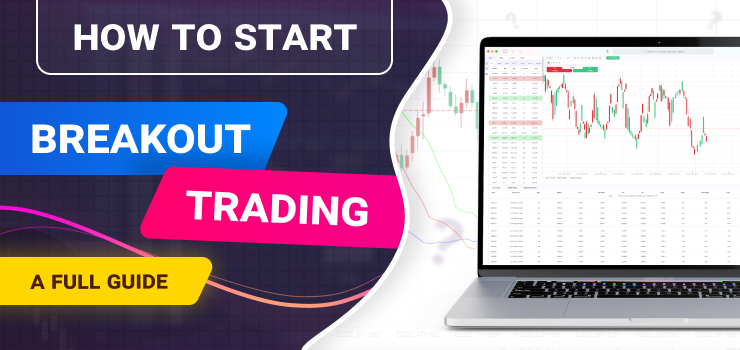Breakout trading is a momentum-based strategy that focuses on capitalizing on large movements in asset prices after they decisively break above resistance levels or below support levels. In this article, we will discuss the key elements of executing a successful breakout trading strategy.
By outlining the full methodology, from spotting breakout opportunities to managing trade outcomes, this article aims to provide traders with a framework for systematically capturing large trends using a breakout trading approach.
What is Breakout Trading?
Breakout trading refers to the strategy of entering the market when an asset’s price moves beyond a defined threshold known as a breakout level. These levels, like support and resistance zones, act as barriers that prices have historically struggled to overcome. A breakout occurs when strong buying or selling pressure causes the price to decisively penetrate these levels.
Breakout traders aim to profit from the resulting momentum by jumping on board as the move unfolds. The break of a key level signals a change in market sentiment that could carry the price much further in the intended direction. Identifying high-probability breakout setups and entering trades precisely at the breakout point allows traders to capture large profitable trends with a strong risk/reward.
How Do You Identify Potential Breakout Levels?
Scanning charts for past levels that temporarily halted price movement helps spot the boundaries that form breakout zones. Price action, volume spikes, and candlestick patterns at these levels provide clues to their relevance.

Common tools include resistance breakouts above downtrending peaks or support breakouts below uptrending troughs. Moving averages like the 20-period SMA also flag dynamic barriers prices gravitate towards. Fibonacci retracement levels derived from prior swings pinpoint percentages at prices that frequently pause.
Comparing breakout levels across various timeframes helps gauge their relative strength. Locations with confluence between multiple indicators usually possess the fortitude to spring prices into extended runs on the breakout. Continual assessment keeps traders acquainted with developing areas primed for potential exits.
How Do You Define Buy and Sell Signals for Breakouts?
Since breakouts may occur at any moment, traders must establish advanced filters to catch entries promptly. Components like chart patterns, momentum oscillators, or volume spikes light the fuse for action.
Bullish breakouts call for closing above resistance, while bearish ones involve breaching support. Identifying reversal patterns like head-and-shoulders tops or double bottoms signals when accumulated pressure could bow barriers. Divergences between an asset’s price and indicators like RSI portend imminent shifts too.

Setting conditional orders above breakout levels capitalizes on the initial momentum. Stop losses beneath broken barriers and protect against whipsaws. Taking partial profits near Fibonacci targets maintains some speculative potential for further upside. With the rules defined in advance, traders remain objective amid high-impact moves.
How Do You Manage Your Risk As A Breakout Trader?

While breakouts offer potentially high rewards, they also carry a sizable risk if the move reverses against positions. Proper trade and risk management become particularly important for consistently profiting from this volatile strategy long-term.
Setting tight initial stops and trailing stops as winners progress limits losses to users’ defined risk tolerance. Diversifying position sizing across multiple anticipated breakouts prevents a single reversal from severely damaging accounts. Exiting positions rapidly if breakout strength fails to materialize prevents rides on dead-cat bounces.
Breakout traders might also scale out of positions in increments to lock in gains and lower average exposure as volatility rises. Monitoring trend strength closely on pullbacks signals when to exit completely versus giving surviving trades more room. The balance between maximizing returns and minimizing risk underpins sustainable breakout tactics.
How Can Breakout Traders Augment Their Strategy?
Some traders enhance traditional breakout methods by integrating additional elements. Sector rotation models help identify leading industry groups more likely to see concentrated breakouts. Sentiment indicators gauge when pessimism has created high-potential reversal setups.
Fundamental analysis on pending events like earnings may supply tailwinds for technical breakout confirmation. Option strategies like buying calls above resistance use leverage while limiting risk. Backtesting price action against established setups and fine-tuning confirmations further optimizes signal filters over time.
Traders also explore diversification through altcoins exhibiting technical similarities to top cryptocurrencies. Options provide steady income potential from volatility in underlying breakouts. MetaTrader experts automate manual processes to free more time for analysis. Breakout strategies evolve endlessly alongside ever-changing markets.
Conclusion | Breakout Trading
Breakout trading leverages strong market structures to potentially deliver large profits in trending environments. With technical and risk management disciplines, traders stand equipped to capture extensions following decisive barrier breaks. As volume drying up signals trend exhaustion, moving targets keep strategies adapting dynamically to precious opportunities as they arise. By consistently evaluating how to start breakout trading, participants refine their edge in chasing momentum.



